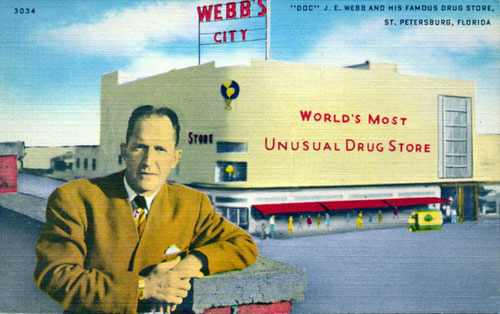
 |
Webb's City |
|
Home Attractions List Books Poster Gallery Timeline
|

Consider the Drug Store as Tourist Attraction (the famous Wall Drug, still going strong in South Dakota, is probably the archetypal example). Born of a desperate need to attract business in the Great Depression, common stores began to employ uncommon methods to get folks in the door. Gimmicks like free ice water, publicity stunts, entertainment -- anything to attract attention. Such a store was Saint Petersburg's own Webb's City. In 1925, James Earl "Doc" Webb, a patent medicine man, bought into a small drug store in Saint Petersburg. By 1926 he had bought out his partner and rechristened the place "Webb's Cut Rate Drug Store," building a business on the philosophy of "Stack it high and sell it cheap" -- the same formula that would later work as well for Walmart's Sam Walton.
It was a formula that would work wonders in the Depression, helping him thrive as other businesses around him failed. Webb began to buy them out and expand -- eventually owning more than seventy stores that spanned seven blocks. From 2nd Avenue South down to 4th Avenue South, his empire covered the area between 7th to 10th Street. Drugs, groceries, hardware, furniture, haircuts, plants, clothing, dry cleaning -- "Doc" Webb sold it all. He ground coffee and shipped citrus. An Arthur Murray studio taught dancing -- on the roof. At its height, Webb employed a staff of more than 1,200 to serve an average 60,000 customers a day. When low prices and selection weren't enough, Doc got creative. He sold dollar bills for ninety-five cents (a limited time offer). He shot the Flying Zacchinis out of a cannon in the parking lot. He exhibited mermaids, chimp acts, and baseball playing ducks. He sold breakfasts for two cents. Eventually, though, the gimmicks just weren't enough. Saint Petersburg, once the tourist capital of Florida, began a long, downward economic slide. The neighborhood deteriorated around Webb City, and not even dancing chickens or huge newspaper ads would lure the people back. "Doc" Webb tried to expand, to open new stores in Pinellas Park and Gainesville, but it just wasn't the same. Ever the visionary, Doc sold out his majority stock holdings in 1974 (he would die eight years later at the age of 85). The company was bankrupt by 1979 and "The World's Most Unusual Drug Store" closed its doors forever. Webb's City did make one important, lasting contribution to retail, however. The Express Check-Out Line (10 Items or Less) was a Webb's City innovation. ("Doc" Webb's son Jim claims the credit).
|
|
Return To Florida's Lost Tourist Attractions, a site celebrating the now defunct tourist attractions of the Sunshine State. The attraction profiled on this page no longer exists. Postcard image courtesy Florida State Archives Photographic Collection.
This site Copyright (c) 1997-2011 by Robert H. Brown
|